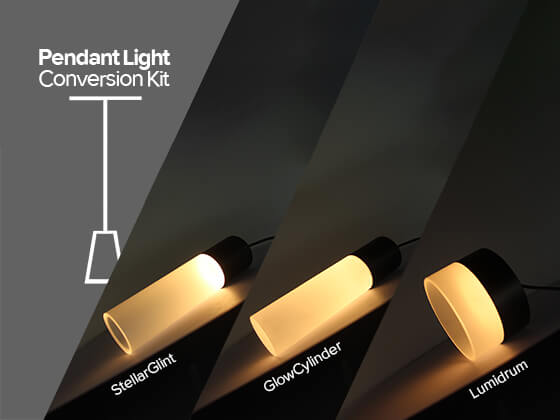Choosing the right color temperature can transform the feel of your space. Yet many people feel overwhelmed when faced with choices like 2700K, 3000K, 3500K, 4000K, or 5000K.
What do these numbers actually mean? And more importantly — how do you know which one is right for your bedroom, kitchen, office, or living room?
In this guide, we’ll walk through each of the five common color temperatures used in modern LED lighting. We’ll explain how they look, how they feel, and where they fit best in real-life settings.
🔶 2700K – The Warmest, Most Relaxing Glow
Color Profile: Warm yellow
Best For: Bedrooms, dining rooms, cozy living spaces
Feel: Like candlelight or traditional incandescent bulbs
2700K lighting is the go-to choice for creating a calm, relaxing vibe. It’s perfect for bedrooms and other areas where winding down matters.
“I love the 2700K setting in my reading nook. Feels like a cozy fireplace even with LED.”
Common Pitfall: In ultra-modern or gray-toned rooms, 2700K can sometimes feel too yellow or old
fashioned.
🔶 3000K – Soft White With More Clarity
Color Profile: Warm, but slightly less yellow
Best For: Kitchens, bathrooms, entryways
Feel: Like boutique hotel lighting
3000K strikes a balance between warmth and usability. It’s often preferred for spaces that need to feel inviting but also practical — like kitchens or powder rooms.
“We used 3000K in the kitchen and it feels cleaner without losing warmth.”
Pro Tip: Great for households that want to maintain a consistent feel across multiple rooms.
🔶 3500K – The Underestimated All-Rounder
Color Profile: Neutral white
Best For: Open-concept living spaces, home offices
Feel: Balanced and adaptable
3500K is often overlooked, but it’s actually one of the most versatile options. It delivers clarity without the harshness of cooler light. If your space has both work and leisure zones, 3500K could be your perfect compromise.
“I chose 3500K for my office/living combo. It doesn’t feel yellow or blue — just right.”
Design Tip: Excellent when you want one color temperature across open spaces without mood shifts.
🔶 4000K – Cool and Crisp
Color Profile: Cool white
Best For: Bathrooms, laundry rooms, garages
Feel: Bright and focused
4000K light improves visibility and color accuracy, making it ideal for spaces where detail matters. Think grooming, cleaning, or task-heavy zones.
“4000K in the bathroom is a game-changer — my mirror actually reflects my true skin tone now.”
Warning: Avoid using 4000K in bedrooms or dining areas unless you love a very clinical aesthetic.
🔶 5000K – Simulated Daylight
Color Profile: Daylight white with bluish tones
Best For: Workspaces, garages, makeup areas, retail
Feel: Alert, energetic
5000K mimics midday sunlight and is often used in professional environments or where visibility is king.
“Great for my garage. But I tried it in my living room and it felt way too harsh.”
Caution: Too much 5000K in living areas can feel cold and uninviting — use sparingly.
📊 Color Temperature Cheat Sheet
|
Color Temp |
Tone |
Best Use |
Vibe |
|
2700K |
Soft white |
Bedroom, Living Room |
Cozy, Relaxing |
|
3000K |
Warm white |
Kitchen, Hallway, Bathroom |
Inviting, Clear |
|
3500K |
Neutral white |
Open Space, Office |
Balanced, Modern |
|
4000K |
Cool white |
Bathroom, Utility Room |
Functional, Bright |
|
5000K |
Daylight |
Garage, Makeup, Workspaces |
Sharp, Energizing |
💡 The Rise of 5CCT Adjustable LED Lights
If you're still unsure, you're not alone.
That’s why more and more LED products now offer 5CCT adjustability — allowing you to switch between these five temperatures using a simple slider or dip switch.
No more guessing. Try 3000K in your kitchen today, and switch to 3500K tomorrow if your walls change color. This flexibility is especially helpful for:
- Open floor plans
- Changing seasons
- Rental properties
- Renovation projects
You’ll find adjustable CCT lighting offered by many brands now — including ours.
📚 What the Experts Say
Leading organizations back these recommendations:
- IES (Illuminating Engineering Society, USA) notes that residential spaces should maintain the same color temperature across fixtures and a CRI of 80+ for true color rendering. It specifically highlights 2700K–3300K as the go-to range for cozy, home-like lighting (CenterPoint Energy Lighting Guide).
- ASHRAE, through its joint standard ANSI/ASHRAE/IES Standard 90.1-2022, emphasizes that lighting should balance energy efficiency with visual comfort and well-being (ASHRAE 90.1 on Wikipedia).
- Guidance from GSA highlights: “Most occupants prefer warmer color temperatures in interior applications, with 3000K and 3500K being the most common preferences.” (GSA LED Guidance)
These expert insights align perfectly with our practical breakdown of 2700K–5000K — reinforcing that a warmer light (2700K–3500K) is generally preferred for living environments, while cooler light (4000K–5000K) suits task-intensive areas.
💬 What People Are Asking (And Now You Know)
We noticed questions like these showing up all over Google and Reddit:
- “What’s the best color temperature for home offices?”
- “Can I use 4000K in a living room?”
- “Is 5000K good for makeup mirrors?”
- “What does 2700K actually look like?”
Hopefully, this guide helped answer them — and gave you new ways to think about lighting not as a number, but as a design decision.
✅ Final Thoughts
Light color isn't just technical — it's emotional.
- Use 2700K for warmth and rest
- Use 3000K–3500K for welcoming, balanced spaces
- Use 4000K–5000K for tasks and focus
Or better yet, choose a lighting solution that lets you adapt.
Lighting is no longer fixed — and neither is your lifestyle.





